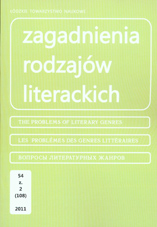Dywersyjny potencjał apokryfu
The Diversionary Potential of Apocrypha
Author(s): Danuta SzajnertSubject(s): Literary Texts
Published by: Łódzkie Towarzystwo Naukowe
Summary/Abstract: Fundamental to the construction of any apocryphal text is its reference to a canon, which could be but is not always biblical. Thus by definition, apocryphal intertextual mediatization relies on the explicit communication of a world view from the perspective of some other, canonical text, as well as the confrontation of its mediums and manners. The authors of some literary apocrypha indict the canon, discrediting it or calling it into question, while others confirm the canon. Yet, in viewing the apocrypha as a complement or a supplement, as the annotation of an established point of view, as a follow−up or a pre- −history of the canonical prototype, we can see our convictions about the canon's external attractiveness and semantic productivity but also its incompleteness and insufficiency. Thus each apocryphal text − at least those that remain related to specific texts − has a critical diversive potential. In this article, I present the results of the apocryphal “hermeneutics of suspicion" arising from a belief in the inevitably flawed nature of any canon, based as it is on an exclusion, a concealment or a marginalization of somebody or something. I have in mind the relatively stable literary canon of Western culture, represented here by literary works like The Iliad, The Tragedy of Hamlet, Les Liaisons dangereuses, Robinson Crusoe ,and Jane Eyre, and also its apocryphal problematization by Margaret Atwood, John Updike, Hella S. Haasse, Michel Tournier, John Maxwell Coetzee and Jean Rhys.
Journal: Zagadnienia Rodzajów Literackich
- Issue Year: 54/2011
- Issue No: 2
- Page Range: 357-372
- Page Count: 16
- Language: Polish

